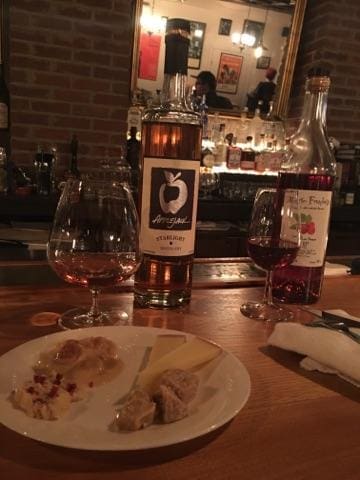Last week, the Digest headed to downtown Jersey City to check out what new cold weather treats Third & Vine had in store for us this season. After successfully converting a Digest staff member (and many other patrons) into vermouth lovers, the cheese and wine bar has stocked its arsenal with a large repertoire of brandy, another genre that’s often been misrepresented. Brian Rothbart, Third & Vine’s beverage director, explained, “Many people in our country are accustomed to a Cognac or an Armagnac type brandy, which are made from grapes. But brandies can be distilled from any fruit — apple, peach, pear, apricot, plum. Any fruit that is distilled is technically a brandy.” This includes everything from Cîroc vodka, which is technically an unaged brandy, to your favorite cognac. Who knew?
In effort to showcase the new lineup (and teach me the proper way to smell booze), Rothbart invited us to the bar. With the dim candlelight flickering, we were given three distinctive categories of brandy with a cheese plate for pairing. In order to help patrons navigate the different types, Rothbart came up with his own unofficial terms for each category.

Young and Lean (unaged brandy)
The first to hit my taste buds was an Italian Grappa. The unaged brandy, Grappa, is traditionally made from pomace, the discarded grape seeds, skins and stems which are all a by-product of the winemaking process. Grappa itself has been around for centuries, and the process has been refined over the years. Rothbart explained, “A lot of Grappa was originally drank by old Italian men. The idea of Grappa was based on a dare to prove their manliness, sold in basements off of the pressings of the wine that they made.” Needless to say, this was the most pungent of the three, which I thoroughly enjoyed. Although Grappa was originally made popular in Italy, it is making itself known around the world, and in this case, right here in Jersey City.
Mature (aged)
These are your Cognacs and Armagnacs, which are classic French styles of brandy made from grapes and aged in oak barrels. Cognac itself can be a blend of two grapes, while Armagnac is generally considered to be a bit more prestigious as it is only allowed to be made from one grape known as Folle Blanche.

For my second tasting however Rothbart unveiled a bottle of Starlight Applejack. Going down it reminded me of a strong dry cider with hints of apple and wood, which was most interesting. Historically, Applejack was made by concentrating cider, by using a method of freeze distillation or as Rothbart calls it “the inverse of distillation.” Conventionally hard alcohol is made through distillation (i.e. boiling the alcohol), but Applejack itself was traditionally the opposite. First created in the 1700s, Applejack is one of the only indigenous beverages of the U.S. and New Jersey. As you can imagine, there are more economical ways to make Applejack today.
Mistelle (fortified wine)
Lastly, and perhaps my favorite, was the Mistelle. Generally a Mistelle is good for after dinner, and it didn’t take me long to understand why. A Mistelle is essentially grape juice or fermented white wine to which brandy has been added. The Marie-Framboise I tried had a subtle blend of juice of freshly harvested grapes and cognac which was infused with raspberries. Like a dessert wine, the combination of organic berries and alcohol went surprisingly well with the brown sugar fudge from our cheese plate (although that didn’t keep me from picking at the 18 month Gruyère).
Aside from the magnificent pairings from all three categories, Third and Vine is offering specialty cocktails featuring many of the brandies. “Cocktails are a language that a lot of people speak. We’re trying to ease people into the flavors that they should expect from the different types of brandies depending on where they come from in the world and the different types of fruit they are made from. This will hopefully help them translate that into their palate vocab that they already have.”
Third & Vine, 353 Third St. (between Newark and Brunswick), Jersey City, NJ 07302

Michael is the Editor-in-Chief of New Jersey Digest and Creative Director at X Factor Media. A Bergen County native, he discovered his passion for storytelling while studying at Montclair State University. In addition to his work in journalism and media, Michael is an avid fiction writer. Outside the office, he enjoys kayaking, a bold glass of Nebbiolo, and the fine art of over-editing.
- Michael Scivolihttps://thedigestonline.com/author/mscivoli/
- Michael Scivolihttps://thedigestonline.com/author/mscivoli/
- Michael Scivolihttps://thedigestonline.com/author/mscivoli/
- Michael Scivolihttps://thedigestonline.com/author/mscivoli/




